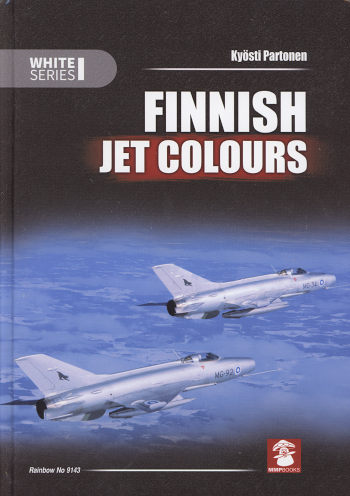MMP Books' Finnish Jet Colours
|
Author: |
Kyӧsti Partonen |
|
Publisher |
Mushroom Models
Publications |
|
Price |
$62.00 from
www.casematepublishing.com |
|
Reviewer: |
Scott Van Aken
|
|
Notes: |
#9143
ISBN 978-83-65281-35-7
216 pages, hardbound, color profiles and photos, 8.25x11.5 inches |
 MMP Books
seems to be on a campaign to provide camo and markings enthusiasts with a nice
line of quality books on those air arms or subjects that have not been all that
well covered. Finland got into the jet business as soon as finances would allow.
Since the choices were fairly limited, they started off with something that was
fairly easy to maintain and provided the service that they needed, which was the
deHavilland Vampire.
MMP Books
seems to be on a campaign to provide camo and markings enthusiasts with a nice
line of quality books on those air arms or subjects that have not been all that
well covered. Finland got into the jet business as soon as finances would allow.
Since the choices were fairly limited, they started off with something that was
fairly easy to maintain and provided the service that they needed, which was the
deHavilland Vampire.
As technology was advancing at quite a clip
during the 1950s, once a plane was in service, it was time to start thinking
about a replacement. This led to the Folland Gnat to replace the Vampire.
Trainers were also deemed to be important and while some Vampire trainers were
purchased, a major purchase was the Fouga Magister.
Finland was forbidden by treaty to have
dedicated bombers, but the air force needed a large plane for target towing and
other secondary tasks so bought a small number of IL-28, which were obsolete for
their primary task at that time. This also led to a small purchase of MiG-15 UTI
trainers and eventually to both the MiG-21F and MiG-21bis fighters.
During this time, the Magisters were replaced
by Bae Hawks and the IL-28s by Lear 35s. The MiG-21s were supplemented by Saab
Drakens and the most recent purchase to replace the MiGs and Drakens is the
F-18C/D Hornet.
Camouflage for the most part consisted of
silver or unpainted metal for some of the types with various camouflage schemes
carried by the rest. The camouflaged schemes were, at time, not specifically
Finnish shades but those the manufacturer thought was close. As Finland
generally assembled the majority of an aircraft order locally, these off-tone
schemes were usually quite limited. Of course, at the 21st century came around,
greys took over with a reduction in both insignia and markings. Like all
nations, there were some special paint schemes and other deviations from the
norm, which is all covered.
A real plus is that Finland has always had
quality photographers on hand to photograph their equipment, something that is
very much appreciated by those researching subjects. In line with other books in the series,
There are superb full page color profiles based on photos of the aircraft in question.
This is all put together in what is an
outstanding reference and inspiration for the modeler. Like other books in this
series, I can easily provide my highest recommendation.
February 2019
Review book courtesy of
www.casematepublishing.com. You can
get yours
at this link.
If you would like your product reviewed fairly and fairly quickly, please contact
the editor or see other details in the Note to
Contributors.
 MMP Books
seems to be on a campaign to provide camo and markings enthusiasts with a nice
line of quality books on those air arms or subjects that have not been all that
well covered. Finland got into the jet business as soon as finances would allow.
Since the choices were fairly limited, they started off with something that was
fairly easy to maintain and provided the service that they needed, which was the
deHavilland Vampire.
MMP Books
seems to be on a campaign to provide camo and markings enthusiasts with a nice
line of quality books on those air arms or subjects that have not been all that
well covered. Finland got into the jet business as soon as finances would allow.
Since the choices were fairly limited, they started off with something that was
fairly easy to maintain and provided the service that they needed, which was the
deHavilland Vampire.